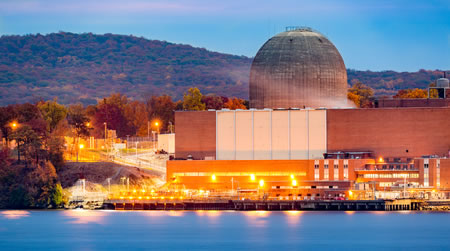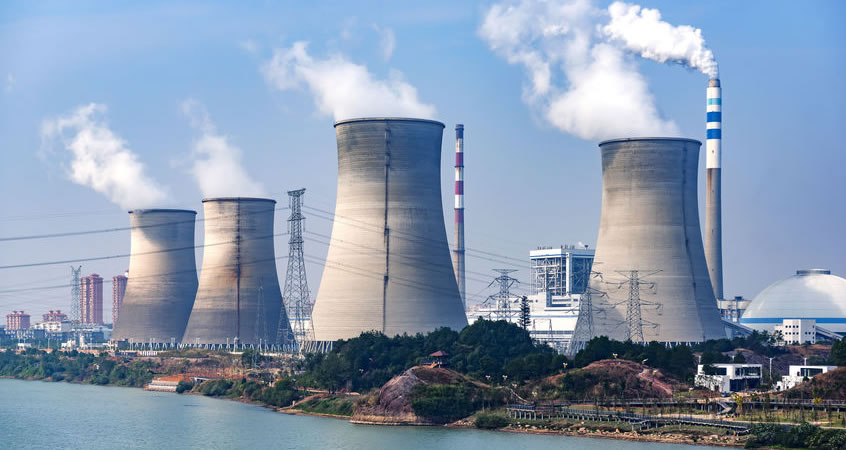ASCE 43 – Changes to the Upcoming Revision 2018

ASCE/SEI Standard 43, “Seismic Design Criteria for Structures, Systems, and Components in Nuclear Facilities,” is a consensus US national standard developed by the American Society of Civil Engineers. It provides design criteria for nuclear structures and should be used in conjunction with ASCE/SEI Standard 4 – “Seismic Analysis of Safety-Related Nuclear Structures”. The two standards are performance based and are written to ensure that structures, systems, and components (SSCs) designed and evaluated in accordance with their provisions meet target performance goals that vary as a function of the seismic design basis. ASCE/SEI 43 was published in 2005 and is currently being revised with the goal of issuing the updated Standard in 2018.
ASCE 43-05 was initiated at the behest of the US Department of Energy (DOE), as were ANS 2.26, ANS 2.27, and ANS 2.29, to integrate the various steps of the seismic design process. Thus, criteria and methods of Seismic Design Categorization (SDC) and the establishment of Limit States to define failure conditions of SSCs were provided in ANS 2.26, and criteria and methods of performing PSHA to establish seismic input motion for analysis and design were specified in ANS 2.29. Also, ANS 2.26 selected performance goals based on the severity of the SSC failure consequence, and the objective of ASCE 43 is to specify design criteria such that the SSC design meets the specified performance goals.
ASCE/SEI 43 (hereafter referred to as ASCE 43) consists of a Foreword plus 10 Chapters arranged as follows:
- Foreword
- Chapter 1 – Introduction
- Chapter 2 – Earthquake Ground Motion
- Chapter 3 – Evaluation of Seismic Demand
- Chapter 4 – Structural Capacity
- Chapter 5 – Load Combinations and Acceptance Criteria for Structures
- Chapter 6 – Ductile Detailing Requirements
- Chapter 7 – Special Considerations
- Chapter 8 – Seismic Qualification of Equipment and Distributions Systems
- Chapter 9 – Quality Assurance Provisions
- Chapter 10 – Seismically Isolated Structures
The revision of ASCE 43 has been reorganized and streamlined. Some design criteria have been removed, simplified, or provided by reference to other codes and standards. As an example, the capacity of structural steel components is now by reference to ANSI/AISC N690 for carbon steel components, ASCE/SEI 8 for stainless steel components, AISI S100 for cold-formed carbon steel components, and ACI 530/ACI 530.1 (ACI 2013b) for reinforced masonry components. Similarly, rather than repeating some provisions of ACI 349, is stated simply that reinforced concrete structures must meet the minimum requirements of ACI 349-13.
One of the more significant changes to the revision of ASCE 43 is that it now includes provisions for Seismic Design Category 2 (SDC‑2) SSCs. This is in contrast to ASCE 43‑05, which only addresses SDC-3 through SDC‑5.
Why the change?
When ASCE 43-05 was written the expectation was that the majority of nuclear facilities would be categorized as SDC‑3 and SDC‑4, and thus that the provisions of ASCE 43 (and ASCE 4) would apply to such facilities. This expectation was a natural consequence of the fact that ANSI/ANS2.26 did not provide a numerical target performance goal for SDC‑2 SSCs because it was not anticipated that major nuclear facilities would be categorized or designed as SDC‑2. It was thought that SDC-2 SSCs would be designed using ASCE 7 and criteria from the International Building Code (IBC). The ASCE 43 Working Group recognizes that there are now many facilities with significant nuclear inventory that are categorized and designed as SDC‑2, and thus this situation should be addressed by ASCE 43.
Target Performance Goal
The ASCE 43 Working Group set the target performance goal for SDC-2 SSCs at of 4 x 10-4 Annual Frequency of Exceedance (AFE), but this does raise a natural question. Namely, why is it that the target performance goal AFE for an SDC-2 SSC appears to be higher in a nuclear standard (ASCE 43) than in the model building code ASCE 7? That is, according to ASCE 43, the AFE for an SDC-2 SSC is higher than the risk adjusted ground motion in ASCE/SEI 7 (ASCE 7) expressed as MCER, which corresponds to a 1% probability of structural collapse in 50 years (i.e. 2 x 10-4 annual probability of collapse). In fact, such a comparison is misleading and inappropriate because the procedures for formulating the performance goals in the two Standards are fundamentally different, namely, performance is judged in ASCE 7 at the system level (building collapse requires the failure of multiple building components) whereas performance is judged in ASCE 43 at the component level.
What This Revision Means
What does the inclusion of SDC-2 in the revision of ASCE 43 mean and how should it be interpreted? In the past, model building codes such as IBC and ASCE 7 have been used to design SSCs categorized as SDC-2. This approach can still be used. It is up to the owner/operator of the facility to choose the design criteria applicable to the facility. Once that decision has been made, the facility should be designed consistent with those criteria recognizing that SDC-2 facilities designed to ASCE 43 criteria will not be identical to SDC-2 facilities designed to IBC and ASCE 7 criteria.
The revision to ASCE 43 uses a different approach for generating Design Response Spectra (DRS) from Uniform Hazard Response Spectra (UHRS). In ASCE 43-05, DRS are generated by using a Design Factor (DF) to scale up a UHRS at the mean hazard defined at 1/10 of the target performance goal. In the new revision to ASCE 43, DRS are generated by using a scale factor (SF) to scale down UHRS at the mean hazard that are defined at the target performance goal. The change in methodology makes essentially no difference in the computed DRS for SDC-4 and SDC-5, and for typical seismic hazard curves makes less than a 5% difference in the DRS for SDC-3.
New Structural Elements Included
The revision to ASCE 43 includes some newer structural elements including steel-plate concrete composite elements and buckling restrained braced frames. It also includes a different formulation for the nominal shear stress of unreinforced concrete, which has been updated from that in ACI 318-14 to account for the effects of section depth, longitudinal reinforcement ratio, and non-exceedance probability on shear strength required of safety-related nuclear structures. This change will affect (and possible increase) the required out-of-plane shear reinforcement of reinforced concrete walls and slabs.
The revised Standard delineates between component level and system level inelastic energy absorption factors (Fm) and describes how adjustments to the component level Fm factors results in the system level Fm factors. The updated provisions also take a more liberal stance on use of adhesive anchors in elevated temperature and/or radiation environments. In ASCE 43-05, this practice was prohibited; now the Standard states that adhesive anchors “…shall be qualified in those environments”, with the new commentary on anchorage stating that adhesive anchors that passed tests per ACI 355.4 (ACI 2011) are acceptable for application to nuclear structures.
Seismic Qualifications Changed
Numerous changes have been made to the chapter on seismic qualification of equipment and distribution systems. Qualification by analysis of active electrical equipment is now prohibited, bringing the Standard into alignment with the provisions of Chapter 13 of ASCE 7. The sections on seismic qualification of equipment and distribution systems by Testing and Experience Data and the associated commentary have been revised significantly to emphasize the differences between qualification by test versus qualification by test experience data and to also update and clarify the factors to be applied to seismic demand for qualification by test, test experience data, and earthquake experience data required to meet the performance goals of the Standard. The restrictions on the use of factors to be applied to seismic demand are also documented.
New Chapter Added
Finally, an entirely new chapter has been added on seismically isolated structures, with emphasis on design and on testing of seismic isolation bearings. The text is taken by-and-large from Chapter 12 of ASCE 4‑16, with the intent that the design and testing provisions and commentary that will appear in ASCE 43-xx, will be removed from the next revision of ASCE 4.
While ASCE 43 was written at the request of the DOE, portions of the Standard are applicable to facilities regulated by the US Nuclear Regulatory Commission (NRC). While the NRC does not endorse ASCE 43 (or ASCE 4) in their entirety, they do endorse specific sections of each standard. In this context, see NUREG/CR-6926 for an NRC evaluation of the applicability of ASCE 43-05 to the seismic design of nuclear power plants and NUREG-0800 Sections 3.7.3, 3.8.1, and 3.8.4 for examples of references to ASCE 4.
References:
- American Concrete Institute (ACI). (2011). “Qualification of post-installed adhesive anchors in concrete and commentary.” ACI 355.4-11, Farmington Hills, Michigan
- American Concrete Institute (ACI). (2013a). “Code requirements for nuclear safety-related concrete structures and commentary.” ACI 349-13, Farmington Hills, Michigan.
- American Concrete Institute (ACI). (2013b). “Building code requirements and specification for masonry structures and companion commentaries.” ACI 530/530.1-13, Farmington Hills, Michigan.
- American Concrete Institute (ACI). (2014). “Building code requirements for structural concrete.” ACI 318‑14. Farmington Hills, Michigan.
- American Institute of Steel Construction (AISC). (2015). “Specification for safety-related steel structures for nuclear facilities, Including Supplement No. 1.” ANSI/AISC N690, Chicago, Illinois.
- American Iron and Steel Institute (AISI). (2007). “North American specification for the design of cold-formed steel structural members.” AISI S100-2007, Washington, DC.
- American National Standards Institute/American Nuclear Society (ANSI/ANS). (2017). “Categorization of nuclear facility structures, systems and components for seismic design.” ANSI/ANS-2.26-2004; R2010; R2017, La Grange Park, Illinois.
- American National Standards Institute/American Nuclear Society (ANSI/ANS). (2016). “Criteria for investigations of nuclear facility sites for seismic hazard assessments.” ANSI/ANS-2.27-2008; R2016, La Grange Park, Illinois.
- American National Standards Institute/American Nuclear Society (ANSI/ANS). (2016). “Probabilistic seismic hazard analysis.” ANSI/ANS-2.29-2008; R2016, La Grange Park, Illinois.
- American Society of Civil Engineers (ASCE). (2002). “Specification for the design of cold-formed stainless steel structural members.” ASCE/SEI 8-02, Reston, Virginia.
- American Society of Civil Engineers (ASCE). (2005). “Seismic design criteria for structures, systems, and components in nuclear facilities.” ASCE/SEI‑43-05, Reston, Virginia
- American Society of Civil Engineers. (ASCE). (2016). “Minimum design loads for buildings and other structures.” ASCE/SEI 7-16, Reston, Virginia.
- American Society of Civil Engineers (ASCE). (2017). “Seismic analysis of safety-related nuclear structures.” ASCE/SEI Standard 4-16, Reston, Virginia.
- International Code Council. (2015). “International Building Code”, IBC 2015.
- Institute for Electrical and Electronics Engineers (IEEE). (2013). “IEEE Standard for Seismic Qualification of Equipment for Nuclear Power Generating Stations.” IEEE 344-2013, Piscataway, New Jersey.
- US Nuclear Regulatory Commission (NRC). (2007. “Evaluation of the seismic design criteria in ASCE/SEI standard 43-05 for application to nuclear power plants” NUREG/CR-6926, prepared by Brookhaven National Laboratory for the US Nuclear Regulatory Commission.
- US Nuclear Regulatory Commission (NRC). (2013). “Standard review plan, Section 3.7.3, Rev. 4, Seismic subsystem review responsibilities”, NUREG-0800.
- US Nuclear Regulatory Commission (NRC). (2007). “Standard review plan, Section 3.8.1, Rev. 2, Concrete containment”, NUREG-0800.
- US Nuclear Regulatory Commission (NRC). (2007). “Standard review plan, Section 3.8.4, Rev. 2, Other seismic category I structures”, NUREG-0800.
Have a question or would like more information? You may post to this blog or click the link below for more help.






